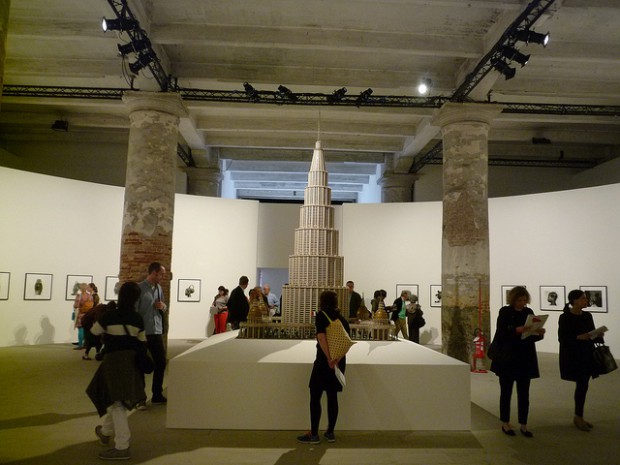Frieze’s Dan Fox is annoyed with people who have complained that this year’s biennale exhibition, “The Encyclopedic Palace”, is too close to a historicizing museum show. According to Fox, some people would have preferred if curator Massimiliano Gioni put together a contemporary art survey, rather than one that included so many outsider artists. In other words, the biennale isn’t commercial enough for some of us art worlders.
A reality check is needed. Anyone who’s looked at the biennale catalogue will see that a large amount of work in the show appears thanks to the support of either galleries or private foundations. That’s not a surprise given the price tag attached to this exhibition—the entire show was launched for under 4 million this year, a pittance considering its size—but it also makes this event a little more commercial than we seem to be willing to admit. Galleries will pay for the work to be shipped to Venice, because it helps them sell works by that artist at Art Basel in Hong Kong, which ran the week before, and Art Basel in Switzerland, which opens next week. We’re told, all the work on display had its shipping donated.
That’s not to say the inclusion of artworks by people like Carl Jung or Emma Kunz purely reflect market demand and interest, but rather that their inclusion needs to meet both conceptual and budgetary needs. In this case, the number of small outsider works included in the show, both meet the curatorial conceit of presenting images that catalog knowledge, while working within a tight budget. Shipping and installing small, largely two-dimensional art is much more cost effective than bringing in enormous works, even if it means building out large walls to display it. This practice almost certainly came into play at the biennale, as the grandeur of the Arsenale was greatly diminished through near-obsessive wall building.

A terrible picture with a Danh Vo sculpture at its foot, taken primarily to demonstrate how walls were often built around massive columns, thereby diminishing the grandeur of the architecture.
That decision kept the architecture from overwhelming the work, a godsend to the biennale, which has historically been burdened by relying on spectacle to compete with the architecture. Not everyone shared this opinion. A Swiss television host I talked to mid-preview worried that fewer people would talk about the show for its exchange of grandeur for intellect. I dismissed the concern briskly, “Do you want a show that people talk about for a news cycle or a show that stands the test of time because it contributes to our understanding of ourselves?” I demanded. “Spectacle doesn’t outlive anyone.”



Comments on this entry are closed.